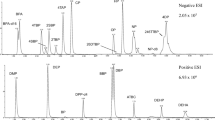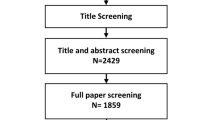Abstract
Aiming the simultaneous determination of widely used organic plastic additives in complex marine matrices, this work proposes a fast and “green” analytical protocol based on quick, easy, cheap, effective, rugged, and safe (QuEChERS) technology. The validation of this innovative method on real matrices (i.e., sediments, mussel, fish, and Posidonia oceanica) indicated a general good performance in all of them for phthalate esters (PAEs), with low blank levels and average method recoveries varying from 54 ± 11 to 71 ± 12%. The best method performance for organophosphate ester (OPE) flame retardants and plasticizers was in biotic matrices (recoveries 52 ± 31 to 86 ± 38%). This application represents an innovative QuEChERS sequence of two dispersive solid-phase extraction (SPE) steps enabling this approach for the determination of important families of organic plastic additives in the marine environment. Indeed, our method allowed the fast screening and simultaneous determination of OPE and PAEs in various sites and matrices subject to different anthropogenic pressure in coastal NW Mediterranean Sea for the first time. ∑7PAE and ∑9OPE concentrations of 19–83 and 27–116 ng g−1 dw (fish), of 80–714 and 42–71 ng g−1 dw (mussels), of 192–908 and 47–151 ng g−1 dw (Posidonia oceanica), and of 11–328 and 4–10 ng g−1 dw (sediment) were measured, respectively. Our approach was sensible enough as to detect differences in the (bio)accumulation patterns of the target compounds in various species and/or sites. This application opens new perspectives for environmentally friendly marine environment monitoring and screening campaigns for organic plastic additives.

Graphical abstract



Similar content being viewed by others
References
Anastassiades M, Lehotay SJ, Tajnbaher D, Schenck FJ (2003) Fast and easy multiresidue method employing acetonitrile extraction/partitioning and dispersive solid-phase extraction for the determination of pesticide residues in produce. J AOAC Int 86:412–431
Baduel C, Mueller JF, Tsai H, Gomez Ramos MJ (2015) Development of sample extraction and clean-up strategies for target and non-target analysis of environmental contaminants in biological matrices. J Chromatogr A 1426:33–47. https://doi.org/10.1016/j.chroma.2015.11.040
Castro-Jiménez J, Barhoumi B, Tedetti M, Sempéré R (2018) Atmospheric particle-bound organophosphate ester flame retardants and plasticizers in a North African Mediterranean coastal city (Bizerte, Tunisia). Sci Total Environ 642:383–393. https://doi.org/10.1016/j.scitotenv.2018.06.010
Cózar A, Sanz-Martín M, Martí E, González-Gordillo JI, Ubeda B, Gálvez JÁ, Duarte CM (2015) Plastic accumulation in the Mediterranean Sea. PLoS One 10:e0121762. https://doi.org/10.1371/journal.pone.0121762
David F, Sandra P, Tienpont B, Vanwalleghem F, Ikonomou M (2006) Analytical methods review. In: Staples C.A. (eds) Series anthropogenic compounds. The Handbook of Environmental Chemistry, vol 3Q. Springer, Berlin, Heidelberg
Eriksen M, Lebreton LCM, Carson HS, Thiel M, Moore CJ, Borrero JC, Galgani F, Ryan PG, Reisser J (2014) Plastic pollution in the world’s oceans: more than 5 trillion plastic pieces weighing over 250,000 tons afloat at sea. PLoS One 9:e111913. https://doi.org/10.1371/journal.pone.0111913
Gałuszka A, Migaszewski Z, Namieśnik J (2013) The 12 principles of green analytical chemistry and the significance mnemonic of green analytical practices. Trends Anal Chem 50:78–84. https://doi.org/10.1016/j.trac.2013.04.010
Greaves AK, Letcher RJ (2017) A review of organophosphate esters in the environment from biological effects to distribution and fate. Bull Environ Contam Toxicol 98:2–7. https://doi.org/10.1007/s00128-016-1898-0
Guo Y, Kannan K (2012) Challenges encountered in the analysis of phthalate esters in foodstuffs and other biological matrices. Anal Bioanal Chem 404:2539–2554. https://doi.org/10.1007/s00216-012-5999-2
Hahladakis JN, Velis CA, Weber R, Iacovidou E, Purnell P (2018) An overview of chemical additives present in plastics: migration, release, fate and environmental impact during their use, disposal and recycling. J Hazard Mater 344:179–199. https://doi.org/10.1016/j.jhazmat.2017.10.014
Hermabessiere L, Dehaut A, Paul-Pont I, Lacroix C, Jezequel R, Soudant P, Duflos G (2017) Occurrence and effects of plastic additives on marine environments and organisms: a review. Chemosphere 182:781–793. https://doi.org/10.1016/j.chemosphere.2017.05.096
Homem V, Silva JA, Cunha C, Alves A, Santos L (2013) New analytical method for the determination of musks in personal care products by Quick, Easy, Cheap, Effective, Rugged, and Safe extraction followed by GC–MS. J Sep Sci 36:2176–2184. https://doi.org/10.1002/jssc.201300190
Hu X, Gu Y, Huang W, Yin D (2016) Phthalate monoesters as markers of phthalate contamination in wild marine organisms. Environ Pollut 218:410–418. https://doi.org/10.1016/j.envpol.2016.07.020
Ibáñez E, Cifuentes A (2017) Comprehensive analytical chemistry green extraction techniques: principles. Elsevier, Advances and Applications
Jambeck JR, Geyer R, Wilcox C, Siegler TR, Perryman M, Andrady A, Narayan R, Law KL (2015) Plastic waste inputs from land into the ocean. Science 347:768–771. https://doi.org/10.1126/science.1260352
Lee R, Lovatelli A, Ababouch L (2008) Bivalve depuration: fundamental and practical aspects. FAO Fisheries Technical Paper 511. Food and Agriculture Organization of the United Nations, ISBN 978-92-5-106006-3. Rome, Italy
Manikkam M, Tracey R, Guerrero-Bosagna C, Skinner MK (2013) Plastics derived endocrine disruptors (BPA, DEHP and DBP) induce epigenetic transgenerational inheritance of obesity, reproductive disease and sperm epimutations. PLoS One 8:e55387. https://doi.org/10.1371/journal.pone.0055387
Meeker JD, Sathyanarayana S, Swan SH (2009) Phthalates and other additives in plastics: human exposure and associated health outcomes. Phil Trans R Soc B 364:2097–2211. https://doi.org/10.1098/rstb.2008.0268
Namieśnik J (2002) Trace analysis — challenges and problems. Crit Rev Anal Chem 32:271–300. https://doi.org/10.1080/10408340290765579
Net S, Delmont A, Sempéré R, Paluselli A, Ouddane B (2015b) Reliable quantification of phthalates in environmental matrices (air, water, sludge, sediment and soil): a review. Sci Total Environ 515-516:162–180. https://doi.org/10.1016/j.scitotenv.2015.02.013
Net S, Sempéré R, Delmont A, Paluselli A, Ouddane B (2015a) Occurrence, fate, behavior and ecotoxicological state of phthalates in different environmental matrices. Environ Sci Technol 49:4019–4035. https://doi.org/10.1021/es505233b
Pantelaki I, Voutsa D (2019) Organophosphate flame retardants (OPFRs): a review on analytical methods and occurrence in wastewater and aquatic environment. Sci Total Environ 649:247–263. https://doi.org/10.1016/j.scitotenv.2018.08.286
Quinnies KM, Harris EP, Snyder RW, Sumner SS, Rissman EF (2017) Direct and transgenerational effects of low doses of perinatal di-(2-ethylhexyl) phthalate (DEHP) on social behaviors in mice. PLoS One 12:e0171977. https://doi.org/10.1371/journal.pone.0171977
Ribeiro C, Ribeiro AR, Maia AS, Gonçalves VMF, Tiritan ME (2014) New trends in sample preparation techniques for environmental analysis. Crit Rev Anal Chem 44:142–185. https://doi.org/10.1080/10408347.2013.833850
Rocha F, Homem V, Castro-Jiménez J, Ratola N (2019) Marine vegetation analysis for the determination of volatile methylsiloxanes in coastal areas. Sci Total Environ 650:2364–2373. https://doi.org/10.1016/j.scitotenv.2018.10.012
Santana-Mayor A, Socas-Rodríguez B, Herrera-Herrera AV, Rodríguez-Delgado MA (2019) Current trends in QuEChERS method. A versatile procedure for food, environmental and biological analysis. Trends Anal Chem 116:214–235. https://doi.org/10.1016/j.trac.2019.04.018
Stubbings WA, Riddell N, Chittim B, Venier M (2017) Challenges in the analyses of organophosphate esters. Environ Sci Technol Lett 4:292–297. https://doi.org/10.1021/acs.estlett.7b00195
van der Veen I, de Boer J (2012) Phosphorus flame retardants: properties, production, environmental occurrence, toxicity and analysis. Chemosphere 88:1119–1153. https://doi.org/10.1016/j.chemosphere.2012.03.067
Wei G-L, Li D-Q, Zhuo M-N, Liao Y-S, Xie Z-Y, Guo T-L, Li J-J, Zhang S-Y, Liang Z-Q (2015) Organophosphorus flame retardants and plasticizers: sources, occurrence, toxicity and human exposure. Environ Pollut 196:29–46. https://doi.org/10.1016/j.envpol.2014.09.012
Acknowledgments
The authors wish to thank Sandrine Ruitton and Melanie Ourgaud for providing the Posidonia oceanica samples, Daniela Banaru for the fish samples, and Etien Castro for the wild mussel samples. Richard Sempéré is acknowledged for giving access to the analytical facilities necessary to develop this research.
Funding
This work was financially supported by the Labex OT-Med - Project ECoMarE (ANR-11-LABX-0061), funded by the French Government “Investissements d’Avenir” (ANR) through the A*MIDEX project (no. ANR-11-IDEX-0001-02). Other financial support includes (i) French Water Agency trough the project CAREMED; (ii) Project UID/EQU/00511/2019 - Laboratory for Process Engineering, Environment, Biotechnology and Energy – LEPABE funded by national funds through FCT/MCTES (PIDDAC); (iii) Project “LEPABE-2-ECO-INNOVATION” – NORTE-01-0145-FEDER-000005, funded by Norte Portugal Regional Operational Programme (NORTE 2020), under PORTUGAL 2020 Partnership Agreement, through the European Regional Development Fund (ERDF); (iv) Investigator FCT contract IF/01101/2014 (Nuno Ratola). The project leading to this publication has received funding from European FEDER Fund under project 1166-39417.
Author information
Authors and Affiliations
Corresponding authors
Additional information
Responsible editor: Roland Peter Kallenborn
Publisher’s note
Springer Nature remains neutral with regard to jurisdictional claims in published maps and institutional affiliations.
Electronic supplementary material
ESM 1
(DOCX 3.30 mb)
Rights and permissions
About this article
Cite this article
Castro-Jiménez, J., Ratola, N. An innovative approach for the simultaneous quantitative screening of organic plastic additives in complex matrices in marine coastal areas. Environ Sci Pollut Res 27, 11450–11457 (2020). https://doi.org/10.1007/s11356-020-08069-9
Received:
Accepted:
Published:
Issue Date:
DOI: https://doi.org/10.1007/s11356-020-08069-9




